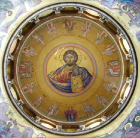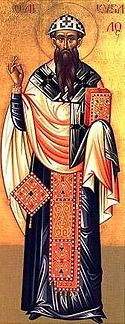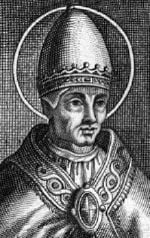Henotikon
| Part of the series on Eastern Christianity | |

| |
|
History | |
|
Traditions | |
|
Liturgy and Worship | |
|
Theology | |
The Henotikon (or "act of union") was a document issued by the Byzantine emperor Zeno in 482 in an attempt to reconcile the supporters of the Council of Chalcedon with the so-called Monophysites, representing the two major divisions within Christianity at the time. Its was followed by the Acacian schism, between Rome and Constantinople, which lasted for 35 years.
The Henotikon was carefully worded to avoid language which offended the opponents of the Council of Chalcedon, which had affirmed "two natures" within Christ rather than one. It also condemned the more extreme faction of the Monophysites, namely the followers of the monk Eutyches. In promulgating this formula of unity, Zeno hoped to placate the increasingly Monophysite provinces of Egypt, Palestine, and Syria, which had experienced a violent reaction to Chalcedon and were also under attacks by the Persian Sassanid dynasty.
Most, though not all, Monophysite (or Miaphysite) leaders were willing to comply with the law requiring adherence to the Henotikon, but Pope Felix III of Rome condemned it and excommunicated Patriarch Acacius of Constantinople for promulgating the edict. The so-called Acacian schism brought a period of intense acrimony between the bishops of Rome and Constantinople through the reigns of several popes and emperors.
Only in 519, when Emperor Justin I officially recognized the excommunication of Acacius and submitted to the authority of the pope, did the schism come to an end. However, the Patriarchs of Alexandria, Antioch, and Jerusalem still embraced Miaphysitism, the theological attitude of today's Oriental Orthodox Churches. The wounds from the division between Rome and Constantinople during the schism would never fully heal.
Background
The Henotikon grew out of the Monophysite controversy in the fifth century. This conflict developed in the aftermath of the condemnation of Nestorianism at the Council of Ephesus in 431. In its aftermath, the anti-Nestorian monk Eutyches expressed the idea of the unity of Christ's humanity and divinity in terms which implied that Jesus was not human in the same sense as other men. Eutyches' condemnation for heresy led to the highly acrimonious Second Council of Ephesus under the leadership of Patriarch Dioscorus of Alexandria, at which Eutyches was restored, his accusers deposed, and a crucial dogmatic letter of Pope Leo I suppressed.
The advent of a new emperor, Marcian, led to the calling of the Council of Chaldedon in 451, which reversed II Ephesus and established the doctrine of "two natures" in Christ as orthodox. Those who had insisted on "one nature" found this unacceptable and had formed schismatic congregations in many parts of the Eastern Roman Empire and Egypt.
When Emperor Zeno (474-91) came to the throne, the Monophysite controversy was at its height. The mass of the people of Egypt and Syria rejected the Council of Chalcedon altogether. Their theological objections to the council's creed was exacerbated by nationalistic and anti-imperial feeling. The three ancient patriarchates of Alexandria, Antioch, and Jerusalem were now in the hands of the anti-Chalcedonian faction, and the Chalcedonian patriarch of Alexandria, Proterius, had been murdered in 457 by a Monophysite or Miaphysite mob.[1]
The Miaphystie patriarch Timothy Aelurus, an ardent disciple of the deposed Diosocorus of Alexandria, had been elected as his successor. Timothy died in 477, and now rival patriarchs had been elected. Peter Mongus‚ÄĒthe "Stammerer"‚ÄĒheld the loyalty of the Monophysite/Miaphysite faction while John Talaia was elected by the Chalcedonian group. Bishop Peter Fullo, also a Miaphysite, occupied the see of Syrian Antioch, and Patriarch Theodosius of Jerusalem was also an anti-Chalcedonian. More than 500 bishops in these patriarchates were open partisans of either Eutychian (Monophysite) or Dioscoran (Miaphysite) christology.
Emperor Zeno found himself in a difficult position. On the one hand he was a friend of Peter Fullo of Antioch and sympathized with the Miaphysites. On the other hand, Zeno had come to the throne as the champion of the Chalcedonian party. He needed the support of the Chalcedonians, because his rival Basiliscus, whom he had deposed, had been the protector of the Monophysites. Anxious to conciliate his old friends in Egypt and Syria, Zeno was keenly aware of how much harm this schism was doing to the empire. He therefore sought to promulgate a new law that was meant to end the controversy in the form of a compromise that he hoped all could accept. This law was the famous Henotikon ("union"), first published in 482.
Summary

Despite its ultimate failure, the Henotikon was a very skillful piece of work. Thought by some to have been drawn up by Patriarch Acacius Constantinople, it began by insisting on the faith defined at the Council of Nicaea, confirmed at the First Council of Constantinople, and also followed by the bishops at the First Council of Ephesus. In these matters, the main parties were in fact agreed. The document proceeded to condemn both Nestorius and Eutyches, the leaders who had come to represent the most extreme versions of the doctrines of "two natures" and "one nature" in Christ respectively. It went on to affirm the curses pronounced by Cyril of Alexandria against the Nestorians, which was a key point to many of the Miaphysites, since Cyril's teaching, though considered orthodox, had informed both Eutyches and Dioscorus.
The Henotikon affirmed that Christ is both God and man, and that he is "one, not two." By avoiding the term "nature(s)" in this formulation, the document sidestepped the main issue, since the main parties agreed that Christ was clearly one person and one being, not two. Those who "divide or confuse" the humanity and divinity of Christ are condemned. One person of the Trinity (the Son) is affirmed as being incarnate, and those who think otherwise are anathematized. Although Nestorius and Eutyches are cursed, there is no word against Dioscorus of Alexandria, who had been deposed at Chalcedon.
Promulgation and reaction
The involvement of Acacius of Constantinople (471-80), in supporting the Henotikon is remarkable, since Acacius had stood out firmly for the Chalcedonian faith even under Basiliscus. Among the Miaphysites, the Alexandrian Peter Mongus accepted the law, noting that it, in effect, nullified the Council of Chalcedon by omitting "two natures" in Christ. Indeed, one result of the law was that Mongus' rival, John Talaia, was banished from Alexandria. At Antioch, Peter Fullo also accepted the Henotikon. However, the stricter Monophysites were not content. They separated themselves from Mongus, forming the sect called the Acephali (akephaloi: "Without a head"‚ÄĒwith no patriarch). Many of the Catholics, Acacius being a notable exception, were not satisfied with the document, since it pointedly avoided declaring the faith of the Council of Chalcedon. To most Catholics, and especially to the papacy itself, Chalcedon was a duly constituted ecumenical council with equal authority to the earlier three.
The Henotikon was addressed first to the African churches, but was then applied to the whole empire. Catholic and strict Monophysite bishops were deposed for refusing to comply, and their sees were given to churchmen who agreed to the compromise. However, the emperor had not counted on the effect of Roman opposition. From all parts of the East, adherents of Chalcedonian orthodoxy sent complaints to Pope Felix III (483-92), entreating him to speak out for the Council of Chalcedon. He then wrote two letters, one to Zeno and one to Acacius, exhorting return to the defense of Chalcedon, which had earlier characterized their stance. John Talaia, exiled from Alexandria, soon arrived at Rome and gave a further account of the effects of the new law in Africa and the East.
The pope then wrote two more letters, summoning Acacius to Rome to explain his conduct. However, the legates who brought these letters to Constantinople were imprisoned as soon as they landed. Under duress, the received communion from Acacius in a liturgy in which Monophysite leaders were honored as holy men.
The Acacian schism
Hearing a report of this through monks loyal to him at Constantinople, Pope Felix held a synod in 484 in which he denounced his legates and formally excommunicated Acacius, declaring him deposed as archbishop of Constantinople. Acacius retorted by excommunicating Felix and striking his name from his diptychs at Constantinople. Thus began the so-called Acacian schism between Constantinople and Rome, which lasted 35 years (484-519).
When the Acoemeti monks, alone at Constantinople, remained in communion with the pope, Acacius put their abbot in prison. Acacius himself died in schism in 489. His successor, Flavitas (489-90), made overtures of reconciliation toward the pope, but refused to give up communion with Miaphysites and to omit Acacius's name in his diptychs, and was thus not acceptable to the pope.
Zeno died in 491. His successor, Anastasius I (491-518), initially kept the policy of the Henotikon. However, Euphemius (490-496), patriarch of Constantinople after Flavitus, tried to heal the schism on relatively generous terms to Rome. He restored the pope's name to his diptychs, denounced Peter Mongus as a heretic, and even accepted the Council of Chalcedon, effectively ending the policy of the Henotikon. However, the pope was still unwilling to forgive Acacius and Flavitas, even after their death, and when Euphemius refused to strike their names from the diptychs, his efforts at reconciliation proved futile. The policy of the East now gradually came to unite more and more with Miaphysitism. When Gelasius I (492-96) succeeded Felix III at Rome, he maintained the same attitude as his predecessor, denouncing absolutely the Henotikon and any other compromise with the "heretics."
Eventually, after Emperor Anastasius died (518), the schism was healed. His successor, Justin I (518-27), was pro-Chaledonian and at once sought reunion with Rome. John II, the new patriarch at Constantinople (518-20), was also willing to cooperate with Rome. In answer to their petitions, Pope Hormisdas (514-23) sent his famous formula of reunion. This formula had been rejected by Anastasius as too much of a capitulation to Rome, but it was now deemed acceptable. The document was signed by the emperor, the patriarch, and all the bishops at the capital. On Easter 519, the union was finally restored, and Chalcedonian Christianity was once again the official religion of the empire.
Legacy
The failure of the Henotikon resulted from its attempt to repress the passionately held beliefs of both the Monophysite and the Chalcedonian groupings within Christianity. In the short term, it also represented a victory for the milder Monophysites, or Miaphysites, who were happy to live under a law which did not require them to assent to the proposition of "two natures."
The "healing" of the Acian schism, meanwhile, represented a triumph for Chalcedon, and even more for Rome, as Homisdas' formula read: "'Thou art Peter; and upon this rock I will build my church' cannot be disregarded." Monophysite bishops were deposed or fled, and the empire was once more officially Catholic. However, Monophysitism was by no means dead. Under Justinian I (527-65), one more attempt would be made to heal the division between Miaphysites and Chalcedonians, this time in the form of Justinian's instigation of the empire-wide condemnation of the so-called "Three Chapters" written by allegedly Nestorian bishops. This attempt, too, brought schism, but also resulted in the grudging, or perhaps forced, compliance of Pope Vigilius at the Second Council of Constantinople.
Excepts from the Henotikon
As recorded by Evagrius Scholasticus, Ecclesiastical History, Book 3. Chapter 3[2]
The emperor Caesar Zeno, pious, victorious, triumphant, supreme, ever worshipful Augustus, to the most reverent bishops and clergy, and to the monks and laity throughout Alexandria, Egypt, Libya, and Pentapolis.
…We were anxious that you should be informed, that we and the churches in every quarter neither have held, nor do we or shall we hold, nor are we aware of persons who hold, any other symbol or lesson or definition of faith or creed than the before-mentioned holy symbol of the 318 holy fathers (at Nicaea), which the aforesaid 150 holy fathers confirmed (at Constantinople); and if any person does hold such, we deem him an alien… Nestorius we also anathematize, together with Eutyches and all who entertain opinions contrary to those above-mentioned, receiving at the same time the 12 chapters of Cyril, of holy memory, formerly archbishop of the holy Catholic church of the Alexandrians.
We moreover confess, that the only begotten Son of God, himself God, who truly assumed manhood, namely, our Lord Jesus Christ, who is con-substantial with the Father in respect of the Godhead, and con-substantial with ourselves as respects the manhood; that He, having descended, and become incarnate of the Holy Spirit and Mary, the Virgin and Mother of God, is one and not two; For we affirm that both his miracles, and the sufferings which he voluntarily endured in the flesh, are those of a single person: For we do in no degree admit those who either make a division or a confusion, or introduce a phantom; inasmuch as his truly sinless incarnation from the Mother of God did not produce an addition of a son, because the Trinity continued a Trinity even when one member of the Trinity, God the Word, became incarnate… And these things we write not as setting forth a new form of faith, but for your assurance: And every one who has held or holds any other opinion, either at the present or another time, whether at Chalcedon or in any synod whatever, we anathematize; and specially the before-mentioned Nestorius and Eutyches, and those who maintain their doctrines…
See also
- Christology
- Council of Chalcedon
- Miaphysitism
Notes
- ‚ÜĎ Miaphysitism shares with Monophysitism a belief in "one nature" in Christ after his Incarnation, but stressed that this oneness as a unity of his divinity and humanity. Miaphysites refer to the teaching of Eutyches as Monophysitism to distinguish themselves from his teachings, which they condemn. In fact Eutyches, too, taught "one nature" as a unity of divinity and humanity, but was alleged also to say that Christ's fleshly being was in some sense different from than of normal humans.
- ‚ÜĎ Evagrius Scholasticus, Ecclesiastical History, Book 3. Retrieved February 6, 2009.
ReferencesISBN links support NWE through referral fees
- Cunningham, Agnes. The Early Church and the State. Sources of Early Christian thought, 4. Philadelphia: Fortress Press, 1982. ISBN 9780800614133.
- Frend, W. H. C. The Rise of the Monophysite Movement. James Clarke Company, 2008. ISBN 9780227172414.
- Fortescue, Adrian. The Reunion Formula of Hormisdas. Garrison, NY: National Office, Chair of Unity Octave, 1955. OCLC 18575489.
- Kreilkamp, Hermes. Rome and Constantinople in the Fifth Century: A Study in the Relationships of Patriarchal Churches. Washington, D.C.: School of Canon Law, Catholic University of America, 1971. OCLC 224325474.
- Walford, Edward (trans.). The Ecclesiastical History of Evagrius: A History of the Church from AD 431 to AD 594. Evolution Publishing, 2008. ISBN 9781889758886.
This article incorporates text from the Catholic Encyclopedia, a publication now in the public domain.
Credits
New World Encyclopedia writers and editors rewrote and completed the Wikipedia article in accordance with New World Encyclopedia standards. This article abides by terms of the Creative Commons CC-by-sa 3.0 License (CC-by-sa), which may be used and disseminated with proper attribution. Credit is due under the terms of this license that can reference both the New World Encyclopedia contributors and the selfless volunteer contributors of the Wikimedia Foundation. To cite this article click here for a list of acceptable citing formats.The history of earlier contributions by wikipedians is accessible to researchers here:
The history of this article since it was imported to New World Encyclopedia:
Note: Some restrictions may apply to use of individual images which are separately licensed.
